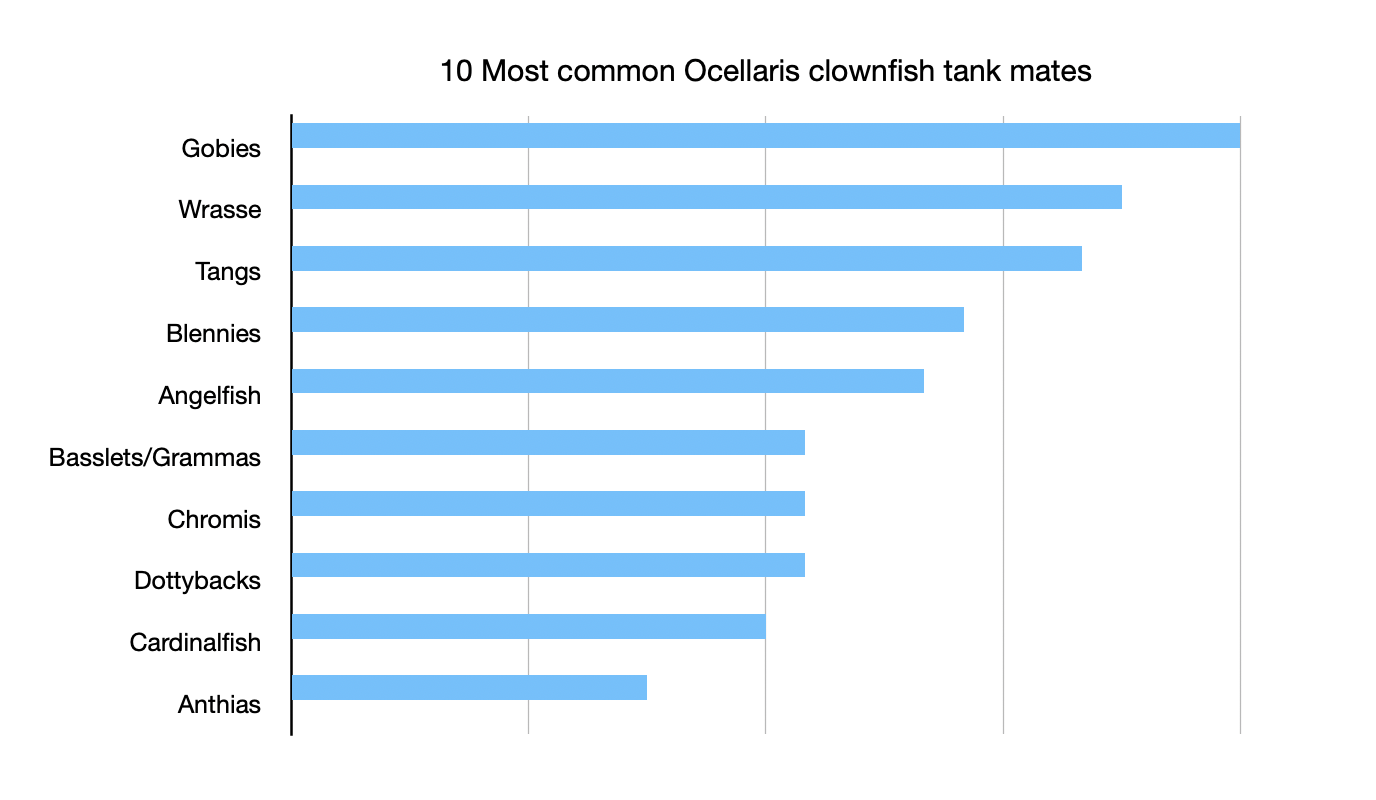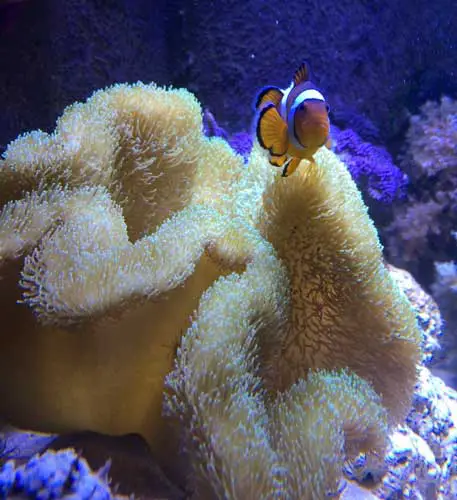Clownfish are the most popular marine fish–and for a good reason. 95% of saltwater aquarium enthusiasts report success caring for them. So let’s explore some of the best clownfish tank mates to keep in your saltwater aquarium.
What makes a fish one of the best clownfish tank mates?
The best clownfish tank mates are peaceful, not aggressive, hardy, not delicate, attractive, not plain, and suited to living in the same environment as the clownfish.
There are so many great clownfish tank mate options that we will explore them across a few different criteria.

Order of adding clownfish tank mates
The order in which you add fish to an aquarium is almost as important as the individual animals that you select. You won’t be able to add an incompatible species by placing it in the right magical order, but you can create aggression and hostility between otherwise compatible species if you add them into the tank in the wrong order.
The reason that the order is so important is that it relates to how each fish defines its own territory within the aquarium and the relative disposition of the other fish as ‘belonging there’ or ‘invading their territory’.
At the risk of over-simplifying this concept, essentially, any fish that are already there when a new fish is introduced into a tank, ‘belongs there’, from the new fish’s perspective, (I know that’s a bit anthropomorphic of me to state that way, but please bear with me to get the concept across), because those fish have always been there. There was no scenario where those fish weren’t there (from the new fish’s perspective).
On the other hand, new fish that are added afterward are interlopers in the space that has been divided up by the fish that were there prior.
As an over-generalized rule, fish that are labeled as more aggressive (either aggressive or semi-aggressive) tend to be more adept at settling into an already established tank, and they also tend to be the type that would be more aggressive to future additions to the tank.

So…the best approach to adding clownfish tank mates is to add them in the order of most peaceful to most aggressive. Add your firefish and small gobies early, and your tangs and angelfish last.
Make a lisT.F.H.research the species, and plan out the order for your best chance at success.
Acclimating clownfish tank mates
The goal of acclimation is to gradually adjust the water chemistry from the bag your clownfish tankmate arrived in to be the same as the water chemistry in your clownfish taT.F.H.f you skip acclimation or rush the process too much, you could stress out, or kill your new purchase.
Step 1: Turn out the aquarium lights and dim the lights in the room you are in, if possible.
Step 2: Open the plastic bag that the clownfish tankmate is in and slowly pour it into a small bucket or other aquarium-safe container that will hold several times the volume of water that is currently in the bag. Avoid ‘dumping’ the bag in. Try to ensure as gentle of a transfer as you can manage.
Step 3: Using a drip acclimation kit, start a slow, siphon-powered drip from the display aquarium into the acclimation bucket. You are targeting a drip rate of about 3 drips per second.
Step 4: After about a half hour, the water in the bucket at this point is about 50% original bag water and 50% aquarium water. Remove 50% of the water in the bucket, return the bucket to approximately the same volume as when you started, and continue the drip for another 30 minutes.
Step 5: Carefully scoop the clownfish tank mate, with some water out of the bucket with the original platic bag, or a hard plastic container (like a food-saver container or an aquarium specimen container).
Step 6: Place the container with your new clownfish tankmate in the aquarium, under the water level, and allow the new addition to swim out.
Step 7: Adjust the timer to allow the lights to come back on the next morning.
The 10 most common clownfish tankmates
There was a survey, in 2022, of Saltwater Aquarium Blog Community Newsletter subscribers. They were asked which fish types they personally had successfully kept as clownfish tank mates. Here are their answers, from 1-10, based on the number of responses indicating successfully keeping them together.

- Gobies
- Wrasses
- Tangs
- Blennies
- Angelfish
- Basslets/Grammas
- Chromis
- Dottybacks
- Cardinalfish
- Anthias
These are relatively large categories of fish, with a bunch of individual species within each group that would be suitable clownfish tank mates

10 Best clownfish tank mates 20-gallon tank
One of the best tank sizes to get started with a clownfish saltwater aquarium is the 20-gallon tank. The 20-gallon long size is better than the 20-gallon high, but either will do.
Here are the dimensions of a 20-gallon tank:
| Tank | Length | Depth | Height |
| 20 Gallon Long | 30 in. (76.2 cm) | 12 in. (30.5 cm) | 12 in. (30.5 cm) |
| 20 Gallon High | 24 in. (61 cm) | 12 in. (30.5 cm) | 16 in. (40.6 cm) |
Not all of the most common clownfish tank mates listed above will be appropriate in a tank that size, so here is a custom list of the 10 best clownfish tankmates for a 20-gallon tank.
- Neon goby
- Tailspot blenny
- Royal gramma
- Banggai cardinalfish
- Pajama cardinalfish
- Firefish
- Purple firefish
- Court jester goby
- Blackcap basslet
- Flame hawkfish
You can learn more about other great saltwater fish for a 20-gallon tank here.
10 Best clownfish tank mates for a larger tank
If you are planning a larger tank, you don’t need to limit yourself to the smaller fish that are suitable for a 20-gallon tank, like above. If you have the space, consider adding a tang, angelfish, betta, wrasse, and even a filefish.

Click any of the names on the list below to learn more about caring for those individual fish species.
- Blue Tang
- Yellow Tang
- Coral Beauty Angelfish
- Flame Angelfish
- Marine Betta
- Fairy Wrasse
- Kole Tang
- Aiptasia-eating filefish
- Yellow Coris Wrasse
- Melanurus Wrasse
10 Best invertebrate clownfish tank mates
So far, all of the best clownfish tan kmates listed have been fish, but when you set up a saltwater aquarium, you have so many more options than just fish! Admittedly, adding invertebrates to your tank does tend to make things a bit more complicated, but it is usually worth it.
Here are the 10 best invertebrate clownfish tank mates:
- Toadstool coral
- Hermit crab
- Hammer coral
- Skunk cleaner shrimp
- Mushroom corals
- Fire shrimp
- Green star polyps
- Peppermint shrimp
- Xenia coral
- Bubble tip anemone
Toadstool, Hammer, and Mushroom corals are some of the best invertebrate clownfish tank mates because the clownfish may call it home and choose to treat it as a surrogate anemone. That is a lot of fun to watch, and those corals are all generally available as aquacultured specimens and are generally hardier than anemones.

The cleaner shrimp and fire shrimp are awesome invertebrate additions so you can watch the natural cleaning behavior.
Green star polyps are gorgeous and easy to care for. Xenia corals rhythmically pulse and will mesmerize you.
Hermit crabs are useful clean-up crew members.
Finally, if you have your mind set on keeping an anemone, the Bubble Tip Anemone is your best bet.
Incompatibilities with certain clownfish tank mates
There are also a few more rules to keep in mind regarding these lists of best tank mates. You can certainly add two clownfish of the same species, but in general, you don’t want to add more than one type of fish to the same tank. You want a maximum of 1 tang, 1 angelfish, 1 wrasse, 1 firefish, and 1 basslet/gramma.
You can add a pair of gobies or cardinalfish, but this tends to only work when you have compatible males/females. If you end up with two of the same gender, one of the two will likely not survive.
10 potential clownfish tank mates to avoid
- Lionfish
- Snowflake eels
- Panther groupers (or other groupers)
- Ribbon eels
- Damselfish
- Green chromis
- Mandarinfish
- Any other clownfishes
- Tube anemones
- Condylactis anemones

Don’t keep clownfish with other clownfishes, damselfishes, or chromis. Be very cautious about mixing them with dottyback species (orchid tends to be one of the most docile). Don’t mix clownfish with condylactis anemones or tube anemones.
Those are not natural anemone hosts and that could spell t-r-o-u-b-l-e for your clownfish.

Mandarinfish are gorgeous, but also notoriously challenging to care for in a home aquarium. They are best left on the reef.
Large predatory fish, like lionfish, panther groupers, and eels may make a snack of your prized clownfish.
Related articles
- 19 Best clownfish types
- Clownfish breeding
- Ocellaris clownfish care
- Snowflake clownfish
- Picasso clownfish
- Maroon clownfish
- Tomato clownfish
- Do clownfish eat their eggs
- Clownfish and anemones
Conclusion
We covered a lot, in a relatively short article here–about 40 of the most common and best clownfish tank mates and 10 potential tankmates that would be a bad idea. Are there any tankmates you didn’t see here that you think should be included? Please leave a comment below.
References
Michael, Scott W. Marine Fishes: 500+ Essential-to-Know Aquarium Species. TFH Publications. Neptune City, NJ: 2001.
Saltwater Aquarium Blog Survey Data 2022.
Ulrich III, Albert B. The New Saltwater Aquarium Guide. Saltwater Aquarium Blog Publications. 2014.
Wilkerson, Joyce D. Clownfishes: A Guide to Their Captive Care, Breeding & Natural History. T.F.H Publications. 2001. Neptune City, NJ

Leave a Reply